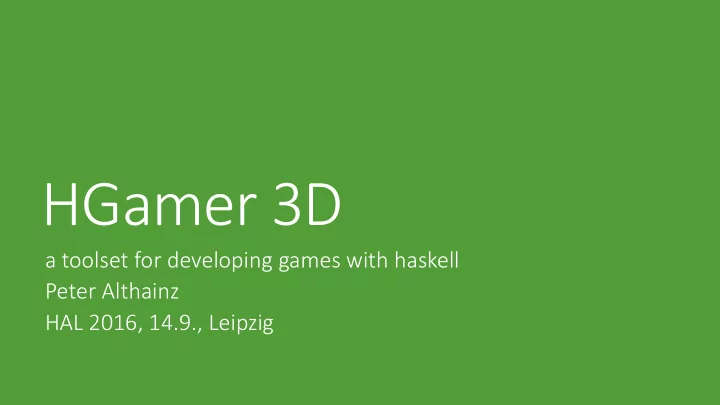

HGamer 3D a toolset for developing games with haskell Peter Althainz HAL 2016, 14.9., Leipzig
Agenda Part I – Intro Part II – What can I do with it ? History API Structure Shortcomings Showcase Game Demo & Features New Approach Architecture API Technology HGamer3D API examples Feature Coverage of HGamer3D
Part I - History
History Started with Irrlicht bindings – cumbersome Then more serious with Ogre3D bindings Got into trouble Spent months with API changes, GUI integration, shader libs Fragmented build process, not working on other computers No binary distribution No media tooling External C-libs are a nightmare for others to build New Approach
New Approach – Fixed It Integrated Engine: Urho3D All parts integrated, shaders as well, build tooling much better Media tooling available Binary Components, Installer Technology Fixed distribution of programs, C-library problem Coarse Grained API Strategy Fixes API stability issues
API Technology „Fresco“ Zero Install Tool – Arriccio (Go) Dependency injection and resolution Web download for your platform Component Runtime – Intonaco (Rust) Lock free data-structures for thread abstraction Intermediate format: messagepack Entity-Component-System Data Description Tool – Sinopia (Haskell) To describe ADT for interface language independent
10 min to install in 5 easy steps: download aio for your platform Results aio Stack setup – resolver lts-5.8 aio CreateProject Happy Customers! ./build ./run The same Haskell code on: Windows / Linux / Mac !
Part II What can I do with it ?
API One Entities Composable from components Reference style CRUD within IO Monad Components are regular ADT‘s Reading & writing fully thread-safe One or more of components are kind-of objects, the other attributes Creation with „newE“ and component list Attributes modify all objects in Entity Threading – behind the scenes All you need to know: Data Types
API Two Only Data Types to memorize
API Three Examples for Sound and Event Handling
API Four Vector Arithmetics with Vect package from Balázs Kőműves Vector substraction, addition, scaling, rotation ... Quaternion arithmetics Examples: Rotation around an axis: „ updateC eGeo ctOrientation (\u -> (rotU vec3Z 0.02) .*. u) “ Implementation of yaw, roll, pitch:
Showcase Game Features Sound, GUI, Key-Input Different game modes Intro Screen Flying / Playing Animated Invaders Fast Key-Input & Shooting Collision Detection by Haskell
Haskell – Game Architecture Actors to partition code and use multi-threading scalable Reader – State – Monad for Actor functions Persistent data types, used a tree for all moving game elements Traversable, to operate on tree Collision detection, send messages of current state to detection actor Not one big loop but multiple small ones, with confined state for each
Actors: looping function within Reader-State-Monad Actors https://www.youtube.com/watch? v=VczbbiRmDik
Structure of program Move Actor: Invader movement Slow beat Screen Canon Actor: Actor: Canon movement Distributes Fast Events beat based on Mode Sound Actor Collision Actor: Collision detection Key Status Actor input Flying Actor
Actors are clearly separated pieces MAIN Create actors Wire them Start beat Send init msg
State Machine for mode handling Screen ActorI gameState is stored in state monad Big switch on gameState Incoming messages are handled depending on current gameState In this actor they are just re- distributed to next actors Example: In pause mode keys are not forwarded, other keys are valid
Depending on mode, messages are distributed to next Screen Actor II actor There are two beats, a fast and a slow cycle beat During gameplay canon movement and collision detection are done more often then movement of invaders
Data Structure (Persistent) Tree structure to be flexible Root Sub-elements move with parent Each element is an Hmap Invader Row Pixel A More: canon, shot, ... Pixel B properties: Cube I Invader I Position Cube I Animation ... Cube II properties: Cube II Invader II Position HG3D Entity ... ... ...
Animation - Traverse over tree
Collision Detection I
Collision Detection II
modular by actors fully multi-threaded Program simple tree data structure Structure HMap for properties fully benefits from beginner/intermediate Haskell Haskell, still API enables this kind of structure beginner friendly style Combines persistent data structure with threading, still being modular No complex Haskell magic needed, uses the basics of FP
Feature Coverage of HGamer3D very basic feature coverage: 3d geometry, GUI, sound, device input, light, material wish-list: particles, effects, animation, network, physics, ... targeting today: education, fun programming, ... included: easy to use beginner friendly API fully multi-threading capable
Outlook let future = fmap (createNewVersions . addFeatures . evolveGame) (Maybe neededTime) www.hgamer3d.org Thank You For Your Time!
Recommend
More recommend